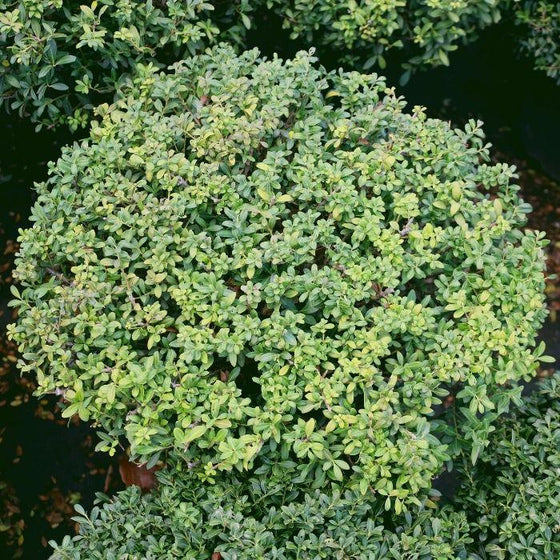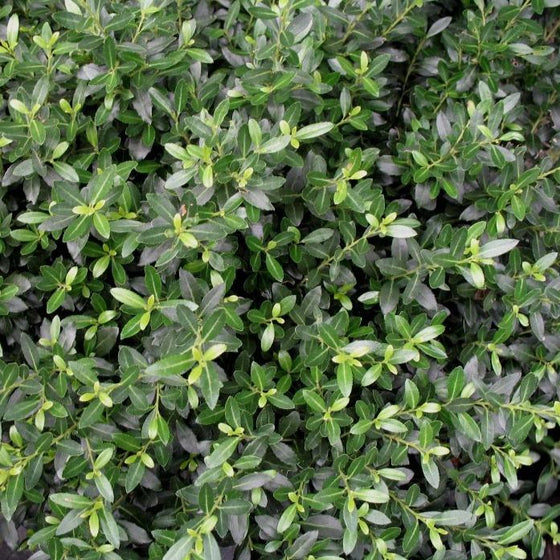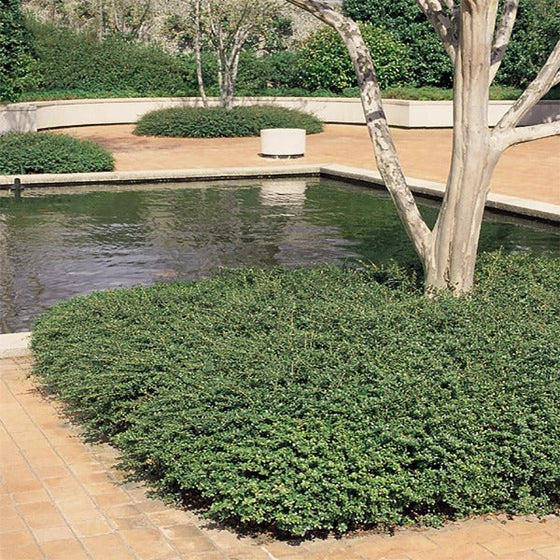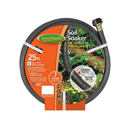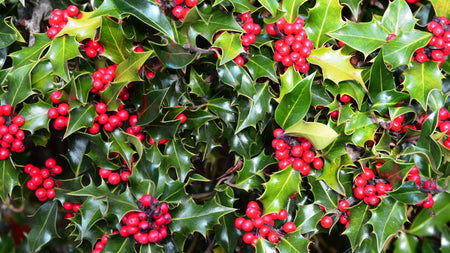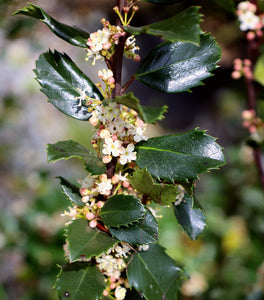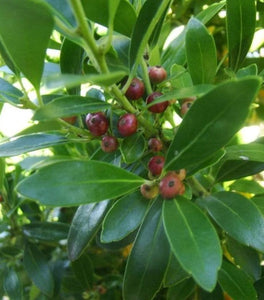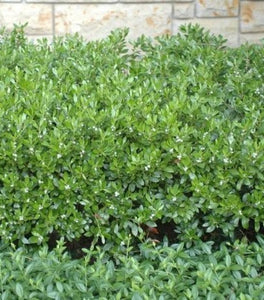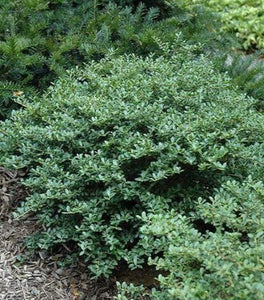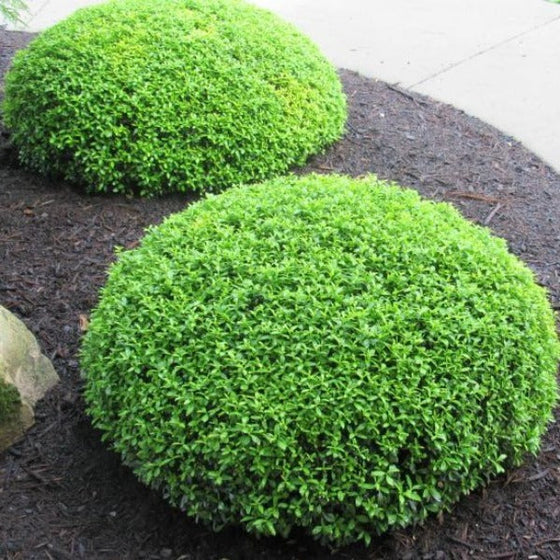
Images Depict Mature Plants
Soft Touch Holly Shrubs for Sale Online
Soft Touch Holly (Ilex crenata' Soft Touch') is a compact, low-growing evergreen shrub known for its soft, glossy green foliage and gentle, rounded form. Unlike many hollies, the leaves of Soft Touch Holly are smooth and spineless, making them ideal for gardens and landscapes where a more delicate texture is desired. This hardy shrub reaches a mature height of 2 to 3 feet with an equal spread, making it perfect for low hedges, borders, or as a foundation plant. Its dense, mounded growth habit provides an elegant, refined appearance that enhances any landscape with year-round interest.
Thriving in USDA zones 5-9, Soft Touch Holly adapts well to various light conditions, from full sun to partial shade, and prefers moist but well-drained soil. It is a low-maintenance shrub that requires minimal pruning to maintain its rounded shape, making it ideal for both formal and informal gardens. Soft Touch Holly produces small white flowers in spring, followed by tiny black berries in the fall, adding seasonal interest and attracting birds to your garden. Its versatility and ease of care make it an excellent choice for homeowners and landscapers seeking a durable, attractive shrub that stays lush and vibrant throughout the year.
In addition to its beautiful appearance, Soft Touch Holly is deer-resistant, adding to its appeal in areas where wildlife is a concern. Whether used in mass plantings, as a ground cover or to add structure along walkways, this shrub's soft, textured foliage provides an appealing contrast to other plants in the garden. With its compact size, low maintenance needs, and year-round green color, Soft Touch Holly is a versatile addition to any garden, delivering a polished, cohesive look while offering a gentle touch to your landscape.
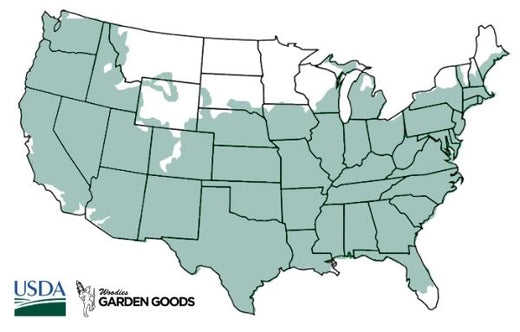
| Hardiness Zone: | 5-9 |
|---|---|
| Mature Height: | 2 to 3 Feet |
| Mature width: | 2 to 3 Feet |
| Classification: | Broad leaved evergreen shrub |
| Sunlight: | Full sun |
| Habit: | Densely branched; mounding |
| Foliage: | Dark green |
| Flower Color: | White flowers that produce black berries |
| Pruning Season: | Prune in late spring to maintain shape |
| Soil Condition: | Any well drained soil |
| Water Requirement: | Water well until established |
| Uses: | Extremely attractive when used as in the mixed border, foundations, or planted in mass |
How to Care for Soft Touch Holly
Before you buy Soft Touch Holly, make sure to read about the recommended care instructions to keep this plant healthy and thriving.
How do I Plant A Soft Touch Holly?
To plant a Soft Touch Holly, start by selecting a location with well-drained soil and exposure to full sun to partial shade for optimal growth. Begin by digging a hole twice as wide as the root ball and just as deep to give the roots ample room to spread and establish. Place the shrub in the hole, ensuring the top of the root ball is level with or slightly above the surrounding soil. This helps prevent waterlogging and encourages proper drainage. Backfill the hole with a mix of native soil and compost to improve soil quality, then water thoroughly to help settle the soil and eliminate air pockets. Mulching around the base of the shrub will help retain moisture and regulate soil temperature, but be sure to keep the mulch a few inches away from the trunk to prevent rot. When planting multiple Soft Touch Holly shrubs for a hedge or border, space them about 2 to 3 feet apart, measuring from the center of each plant. This spacing allows the hollies to grow together and form a dense, attractive hedge or ground cover without overcrowding. During the first growing season, water the plants regularly to keep the soil consistently moist but not waterlogged, which helps the root system become established. Soft Touch Holly is a low-maintenance shrub, and with the right planting techniques, it will thrive, providing a lush, compact, and attractive addition to your garden year-round.
How do I Water A Soft Touch Holly?
To properly water a Soft Touch Holly, focus on deep and consistent watering, especially during the first year after planting to establish a strong root system. Water the shrub deeply once a week, making sure the moisture reaches a depth of 6 to 8 inches. This encourages the roots to grow deeply, making the plant more drought-tolerant in the future. During hot or dry periods, increase the watering frequency to prevent the soil from drying out completely. Always water at the base of the plant, avoiding the foliage to reduce the risk of fungal diseases. Mulching around the base of the shrub helps retain moisture and regulate soil temperature, reducing the need for frequent watering. Once Soft Touch Holly is established, it becomes more drought-tolerant and will require less frequent watering. However, during prolonged dry spells or extremely hot weather, it's important to water deeply every 10 to 14 days to maintain its vibrant, glossy foliage. Regularly check the soil moisture by digging a few inches down—if the soil feels dry, it's time to water. Avoid overwatering, as Soft Touch Holly prefers well-drained soil and can suffer from root rot if left in overly wet conditions. With proper watering practices, your Soft Touch Holly will thrive, providing lush, green foliage and enhancing your garden with year-round beauty.
How do I Fertilize A Soft Touch Holly?
Fertilizing Soft Touch Holly (Ilex crenata 'Soft Touch') is essential to promote healthy growth, dense foliage, and the plant's signature soft-textured appearance. The best time to fertilize Soft Touch Holly is in early spring, just as new growth begins to emerge. Use a balanced, slow-release fertilizer formulated for acid-loving evergreen shrubs, such as one with an N-P-K ratio of 10-10-10 or 10-5-5, to provide the nutrients necessary for robust root development and vibrant leaves. Spread the fertilizer evenly around the base of the holly, focusing on the root zone while avoiding direct contact with the trunk to prevent root burn. After applying fertilizer, thoroughly water the area to help dissolve and distribute the nutrients to the roots. Conducting a soil test before fertilizing Soft Touch Holly is highly recommended to determine if the soil lacks specific nutrients or if the pH needs adjustment. These shrubs thrive in slightly acidic soil with a pH between 5.0 and 6.5. If needed, add soil amendments to create the ideal growing environment for your holly. In addition to spring fertilization, a light feeding in mid-summer can help boost the plant's growth and maintain lush, healthy foliage. Avoid late-season fertilization to prevent new growth that might not harden before winter. With the right fertilizer and proper care, your Soft Touch Holly will thrive, maintaining its attractive, low-growing form and enhancing your garden with year-round color and texture.

How do I Prune A Soft Touch Holly?
To prune a Soft Touch Holly, start by performing light pruning in early spring, just before new growth begins. Use clean, sharp pruning shears to remove any dead, damaged, or diseased branches, which helps improve airflow and promotes healthy growth. Pruning in early spring ensures that the shrub has time to recover and encourages a denser, more compact form, which is perfect for creating low hedges or well-defined borders. When shaping, focus on maintaining its naturally rounded growth habit by trimming back any wayward branches that detract from its appearance. This light pruning helps keep the Soft Touch Holly looking neat and well-manicured while encouraging bushier growth. Soft Touch Holly is generally a low-maintenance shrub, and additional pruning throughout the growing season may only be necessary if it becomes overgrown or loses its shape. If further pruning is needed, do so in mid-summer, but avoid heavy pruning late in the season to prevent stimulating new growth that could be damaged by winter frost. Always aim for a natural shape and avoid cutting back more than one-third of the shrub at a time to avoid stressing the plant. With regular, minimal pruning, Soft Touch Holly will maintain its attractive, dense form and continue to provide lush, glossy foliage that enhances your garden with year-round visual appeal.

